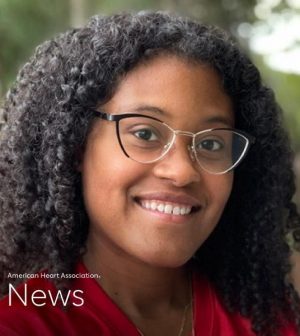- Skip Storing This Everyday Product in the Fridge Door
- Green Tea + B3 Pairing May Boost Brain Health
- Navigating Your Midlife Crisis: Embracing New Possibilities
- City Raccoons Showing Signs of Domestication
- Mapping the Exposome: Science Broadens Focus to Environmental Disease Triggers
- One Week Less on Social Media Linked to Better Mental Health
- Your Brain Changes in Stages as You Age, Study Finds
- Some Suicide Victims Show No Typical Warning Signs, Study Finds
- ByHeart Formula Faces Lawsuits After Babies Sickened With Botulism
- Switch to Vegan Diet Could Cut Your Greenhouse Gas Emissions in Half
AHA News: At 26, Elementary School Music Teacher Had a Stroke Between Classes

TUESDAY, Jan. 25, 2022 (American Heart Association News) — Christina Saldivar felt well-rested and energetic when she headed to her elementary school in Newport News, Virginia, on a Monday morning in February 2020. At 26, she was enjoying her first year of teaching music at the same campus instead of bouncing around as an itinerant teacher.
The morning opened with back-to-back classes to second and first graders. Using simple instruments like recorders and rhythm sticks, she taught the children tone and rhythm.
Next up, she was taking kindergarteners to the gym to dance. First, she needed to use the restroom.
While in a stall, she felt overcome by a headache so powerful that it felt like someone was hammering against the front of her skull.
Then came waves of nausea and lightheadedness. She tried to vomit but couldn’t.
The next thing she knew, she woke up on the floor of the stall. The germaphobe in her wanted to jump up, but she lacked the energy.
From her smartwatch, she called one of the physical education teachers. “Can you bring my class to the gym?” she had asked. “I think I’ll be late getting there. I don’t feel so well.”
“Should I send the nurse?” the PE teacher asked.
“No, no. I’m OK,” Saldivar answered. As she spoke, the hammering blows began spreading across her entire head.
“Wait, yes, go ahead and send the nurse,” she said into her watch before blacking out a second time.
Her next memories are murky. A school administrator and nurse talking to each other about her. Being inside an ambulance. Waking up in the emergency room.
Meanwhile, school staff had called Saldivar’s partner, Brean Hicks-Bailey, and Saldivar’s mother, Catherine Saldivar. Hicks-Bailey arrived at the school from their home in Hampton, Virginia, just as Saldivar was getting into the ambulance. He drove to the hospital and her mother met him there.
“We had no idea what could be going on,” Hicks-Bailey said. “It was so confusing.”
A doctor later explained that Saldivar had a ruptured brain aneurysm. Essentially, a blood vessel in her brain burst. This sent blood into the surrounding area, causing what’s called a hemorrhagic stroke.
Just as they were processing that devastating news, the doctor said Saldivar needed to undergo a procedure to stop the blood from flowing into the damaged area. Saldivar was treated with a technique called coiling. Coiling closes off the blood flow into the aneurysm by packing it tightly with detachable platinum coils. It is performed through a catheter from the groin extending to the brain.
Recovery usually takes a couple days. But Saldivar was in the hospital for two weeks because her headaches continued. Doctors readjusted the coiling, then monitored her for several more days.
Saldivar went home with virtually no physical or cognitive deficits. She also went home confused: Why had this happened to her?
In the hospital, her ongoing headaches kept her from using her phone or computer. Once she got home, she felt strong enough to research it all.
And soon, she had plenty of time to do it. She was released in early March 2020, days before the COVID-19 pandemic hit.
After reading about strokes and aneurysms, Saldivar realized how lucky she was that things played out as they did.
“I’d heard about F.A.S.T. but didn’t really pay attention,” she said, referring to the acronym to help people remember the signs of a stroke: Face drooping, Arm weakness or Speech difficulty mean it’s Time to call 911. “And I definitely didn’t know someone my age could have a stroke.”
The question of why it happened remains a bit of a mystery. Her neurologist found no explanation. Alas, doctors are now monitoring another smaller aneurysm. She may need the same procedure done to prevent this bubble from bursting.
As a young strong survivor, Saldivar struggled to find others who could understand what she’s been through and the aftermath. Online supports groups have helped. So has her cat, Butter.
“As soon as I came home from the hospital, he started snuggling and has literally stayed by my side,” she said. “He helps with my stress level, which I’m trying to monitor.”
Last year, Saldivar became pregnant. She was considered high risk because of her stroke. While she delivered prematurely at 36 weeks, that was due to an unrelated cause. More importantly, she had a healthy son named Brean Jr.
American Heart Association News covers heart and brain health. Not all views expressed in this story reflect the official position of the American Heart Association. Copyright is owned or held by the American Heart Association, Inc., and all rights are reserved. If you have questions or comments about this story, please email editor@heart.org.
By Diane Daniel
Copyright © 2025 HealthDay. All rights reserved.










